There is a boundary layer – of iridium – above which there are no dinosaur bones to be found – because the dinosaurs were killed off by whatever laid down that world-wide layer of iridium separating the last era of the dinosaurs from all of the subsequent eras.
When people from a future era look back at ours, they may also notice a layer of iridium – so to speak – separating their era from ours.
The one in which mighty mechanical sauropods such as the Infiniti QX still roamed the roads. 
What It Is
The QX80 is a full-size/three-row SUV based on the Nissan Armada – both of which are related to Nissan’s full-size/half-ton pick-up, the Titan. All three are powered by a 5.6 liter V8, paired with an automatic transmission and either rear-drive or four-wheel-drive (with a transfer case and 4WD Low range gearing).
The Q – being an Infiniti – is layered with luxury features that aren’t standard (and some, not offered) in either of its two Nissan-badged relations. These include a self-leveling air suspension, three-zone climate control, leather seats, a heated steering wheel, 20 inch wheels and a 13 speaker Bose premium audio system .
Which is why the Q’s base price – for the Lux trim – is $71,100 for the rear-drive version and $74,200 for the 4WD version vs. $49,500 for the Nissan badged version of essentially the same thing, in terms of function if not amenities. 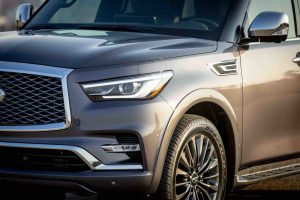
The Premium Select adds 22 inch wheels, dark chrome exterior trim and some additional options as regards the color of the leather seats. It lists for $75,400 for the rear-drive version and $78,500 with 4WD.
A top-of-the-line Sensory comes with a Body Motion Control System to counteract . . .body roll when the big Q is cornering and a 17 speaker even-more-premium Bose audio system, as well as a larger, new-design LCD screen in the center stack and a pair of 8-inch entertainment screens for those in back.
It stickers for $82,250 with rear-drive and $85,350 with 4WD.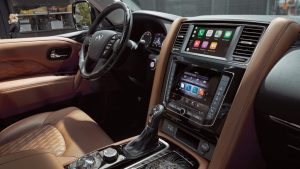
What’s New
Very little – since 2011 – which is a very good thing, if you think too much in the way of the newest “driver assistance technology is a bad thing. And if you think a standard 400 horsepower V8 without turbos or fewer cylinders (and a solid rear axle) are good things.
Another good thing is that Apple Car Play and a wireless phone charger are now standard.
What’s Good
Appropriately sized engine – for a rig this size.
Rugged body-on-frame construction.
Doesn’t “assist” your driving as much as newer models do.
What’s Not So Good
No more engine than you could get in the less adorned but essentially the same thing Nissan-badged Armada – for $21,600 less (the difference in price between the $71,100 base price of the ’22 QX80 and the $49,500 base price of the Armada.)
Possibly polarizing guppy-face styling.
Almost as expensive to fuel as it is to buy.
All QX80 trims come standard with the same engine, which is the same 5.6 liter, 400 horsepower V8 engine that also comes standard in the Nissan Armada (and Titan pickup).
There is nothing wrong, as such, with this engine – which is appropriately sized and appropriately powerful for a big SUV. It endows this kahuna with the strength to pull 8,500 lbs. and to move its 5,687 curb weight from inert to 60 in 5.9 seconds – putting its straight-line acceleration capabilities ahead of those of most V8-powered muscle cars of the ’60s and ’70s that in many cases weighed a ton – literally – less.
It also manages to deliver 14 city and 20 on the highway – remarkable for something this big, this heavy and this big-engined. With 26 gallons of fuel in its tank, it can also travel 520 miles on the highway (364 miles in the city). Either figure easily bests the best-case range of any electric car – or truck. Including the newly electrified version of Ford’s F-150 pickup, which can only go a pathetic 230 miles with its standard battery and a meager 320, with its extra-cost battery.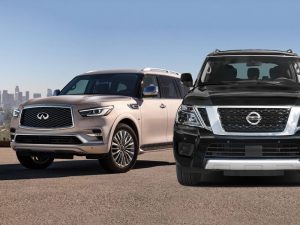
However, the 5.6 V8 that powers the Q isn’t any stronger (or bigger) than the same engine used in the Armada and Titan, which may be off-putting to some potential buyers who expected more engine for the additional $20k-plus they paid for their Q.
Other high-end models in the same general class that share their bones with less-adorned models in lesser classes – such as the Cadillac Escalade (based on the Chevy Tahoe) do come standard with more (and bigger) engines than are standard in the models they derive from – e.g., a 6.2 liter, 420 horsepower V8 in the Escalade vs. a 5.3 liter, 355 horsepower V8 in the Tahoe.
On the other hand, the Tahoe is available with the same 6.2 V8 that’s standard in the Escalade.
However, the price gap isn’t as yuge as that which separates the QX80’s base price from the same-engined Armada’s. Chevy offers the 6.2 V8 that’s standard in the Escalade as a relatively affordable $3,815 option added to the $58,300 MSRP of a Tahoe RST, totaling $62,115 – or $14,180 less than the $72,295 base price of an Escalade. 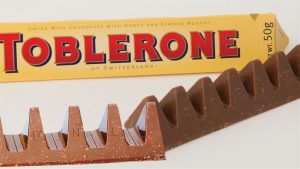
Money aside, you still get a lot for it.
Literally. In that engines are getting smaller, generally – even in the biggest vehicles. Some of them, like the Lincoln Navigator – another model in the Q’s class – come only with a 3.5 liter V6. Same goes for the just-redesigned Lexus LX600, which comes with a 3.4 liter V6. The only reason the QX80 still comes with an engine almost twice that size is because it’s very old even though the current Q is brand-new, in terms of the model year. But it’s nonetheless largely the same Q as the 2011 Q, which was designed before the onslaught of Wokist regulations that have made big V8s persona non grata under the hoods of practically everything, including even big SUVs.
It probably won’t be long before “big” V6s are similarly anathematized.
So, carpe diem. Like, today. Because it is probable that, come tomorrow, the Q may have . . . transitioned.
The 5.6 V8 is paired with a seven speed automatic and either 2WD (rear-drive) or 4WD, the latter with an electrically controlled two-speed transfer case and 4WD Low range gearing. All trims also come standard with 9.2 inches of ground clearance, whether 2WD or 4WD and a standard 8,500 lb. max tow rating.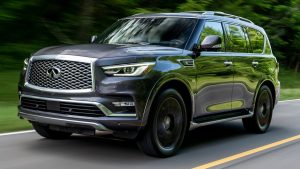
On The Road
Why are big SUVs vastly more popular than cars? it is probably because big SUVs are so much like cars used to be, when they were still big – and had big V8s under their hoods. Almost no such new cars are available – chiefly on account of the decades’ long regulatory effort to render cars (and their engines) ever smaller, in the name of making them more “fuel efficient.”
You’d think it ought to be up to buyers – of cars and otherwise – to decide for themselves whether “fuel efficiency” is more important than bigness, of the machine or the machine that powers the machine. But that is not what government thinks. Or rather, what the politicians who tell the bureaucrats who decide what you’ll be allowed to decide, think.
Big SUVs are still around – but only because it took about 20 years for the “fuel efficiency” standards applied to cars to be applied the same to them as to cars. Now that they are, you will understand why big engines are disappearing in big SUVs like most of the QX80’s major competitors (with the lingering exception of the Caddy Escalade).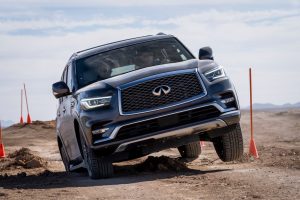
The bigness – of the SUV, itself – appeals for the same reasons it once did as far as cars. There is room to spread out and the weight that usually attends size is comforting in the way that being aboard a battleship rather than a dinghy is comforting. There is a heavy-gauge steel frame underneath you, serving as the keel of this mighty dreadnought.
And a solid axle in back that is less likely to break.
But it is the big V8 under the hood that sets it apart, in the manner of 16 inch vs. 11 inch guns.
Certainly, turbo-boosted sixes (mildly electrified, too) can emulate and even exceed the horsepower produced by the Q’s “guns” – but they do not, they cannot, produce the sounds. These do not make the Q ship any faster. But there are metrics that specifications don’t convey. Such as the 16-inch bellow produced by 5.6 liters of V8.
Or the burble.
There is also the knowledge – that you have what so many others no longer do. Not in a sneering way. You are the keeper of the flame. The custodian of something special; the thing which once – in the Before Time – was what most people had. Or could have, if they wanted. And not only do you still have it – you can share it with others, so that they, too, know what it was like, in the Before Time.
Speaking of that.
While the current Q is new it is also old – as in design and thank God for it. For that reason, it is less encumbered by the electronic idiot-proofing styled “driver assistance technology” that the newest vehicles have more of and which is also more peremptory, as well as more difficult to disable.
In many cases, you cannot entirely disable some of these “advanced” features.
You can in the Q. Which makes driving the Q a great deal less harrying since the Q leaves you alone while you’re driving.
Which, by the way, you can do for a long time, despite that big V8 under the hood and the near-6,000 pounds of Q (plus you) it’s moving along. Five hundred twenty miles on the highway; 364 in the city. Both longer than anything “electrified” – and you’ll wait less long, too, before getting back on the road.
It is big, however.
Nearly as long as the biggest American sedans of the Before Time – and much taller. And yet it corners far better – notwithstanding it stands twice as high off the road as most cars. It corners even better with the new Body Motion Control System – but even without it. The cornering tenacity of modern SUVs far exceeds that of the big sedans of the ’70s – as well as the daring of many drivers.
But all drivers will appreciate the poshness of how this big rig rolls.
And the mellow sounds accompanying, as it rolls.
At The Curb
How big is the Q? End to end, it stretches 210.2 inches – which isn’t quite as long as the Caddy Escalade (211.9 inches) and not nearly as long as the new Jeep Wagoneer (214.7 inches) but all of these SUVs are nonetheless longer than just about any new car, even what are styled “full-size” cars, as for instance the Mercedes S-Class sedan, which is 208.2 inches long and does not seat eight – or even seven. Nor can it accommodate more than a small fraction of the stuff that will fit inside the 95.1 cubic feet of available space within the Q.
The Escalade has even more space – 121 cubic feet, total (and 25 cubic feet even with its three rows up).
But the take-home point is that big SUVs like these have several times as much space for both stuff and people than even the biggest new cars – and that (plus the big V8s) are why these big SUVs are so much more popular than today’s big cars.
Also more affordable.
Well, in relative terms. The Q’s base price about $40k less the base price of an S-Class, which no longer comes standard with a big V8. If you want that, it’ll cost you another $7k on top of the extra $40k. The Wagoneer does come standard with the biggest V8 you can get in any new SUV – 6.4 liters and 471 horses. But it also has a bigger base price – $87,995 – which is some $15k bigger than the base price of the Q.
Now, the Q’s shape – rather than its size – may not appeal to everyone. The front end, in particular, which is brachycephalic in the manner of a Guild Navigator from the movie, Dune.
But the exterior visuals are in the eye of the beholder and so we’ll leave it at that.
Inside you will find analog gauges and a grab-handle gear selector – a recollection of the era before flat screen gauges and tap-button/knob controllers. Both of the former are more immediately comprehensible and also more tactile. They are apt to be more durable, too – in terms of their visuals. Today’s flat screen gauge panels and electric tap-swipe interfaces may look hip and with it today. But how about five years from now? 
How good does a five year old cell phone look, today?
The Rest
What will 2023 bring?
Probably fewer of these already-not-many big SUVs with big V8s. Lexus, as mentioned earlier, has already replaced the big V8 that used to come standard in the LX560, which is now the V6-powered LX600. GM is in love with electric cars; the non-electric/V8-powered Escalade sticks out like a red-headed stepchild among GM’s current lineup and its future in its current configuration does not seem bright.
It has been announced that Jeep – well, the parent company of Jeep – is not going to be making Hemi V8s by circa 2024, these to be replaced by a partially-electrified six.
So vehicles like the Q and its kin are the last of the proverbial Mohicans.
The Bottom line
Time’s short, if big is what you want. Outside – and under the hood.
. . .
Got a question about cars, bikes or anything else? Click on the “ask Eric” link and send ’em in! Or email me directly at [email protected] if the @!** “ask Eric” button doesn’t work!
If you like what you’ve found here please consider supporting EPautos.
We depend on you to keep the wheels turning!
Our donate button is here.
If you prefer not to use PayPal, our mailing address is:
EPautos
721 Hummingbird Lane SE
Copper Hill, VA 24079
PS: Get an EPautos magnet or sticker or coaster in return for a $20 or more one-time donation or a $10 or more monthly recurring donation. (Please be sure to tell us you want a magnet or sticker or coaster – and also, provide an address, so we know where to mail the thing!)
My eBook about car buying (new and used) is also available for your favorite price – free! Click here. If that fails, email me at [email protected] and I will send you a copy directly!


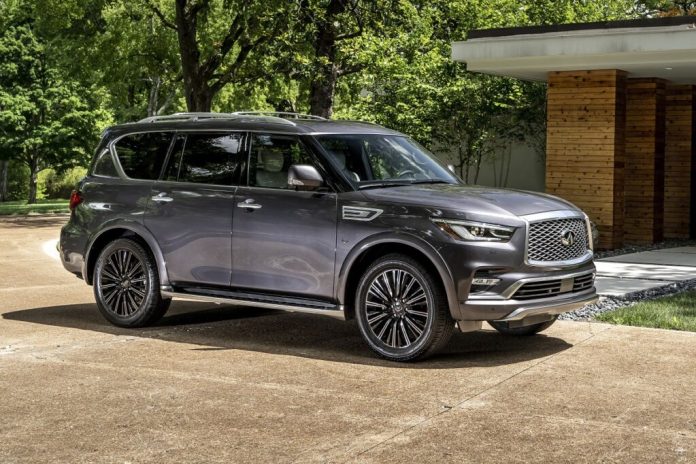

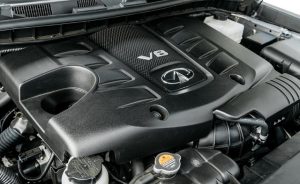








I want one! But minus the Yyuuuggee price. Almost bought a used one this past spring but stil too much $ for me to justify. Even with big gas price increases, the long term durability and lower cost of operation make them extremely appealing. And the biggest factor, injury free accident protection, due to sheer size and construction, make them an actual bargain, even with gas at crazy high prices right now. In 2008/9, when gas skyrocketed, large numbers of these kinds of vehicles went to rock bottom prices. I should have gotten two then and just drove them sporadically. True masterpieces of engineering for moving large amounts of people and stuff safely and economically. I’m inclined to not to make the same mistake twice.
Had an Armada once a time. It was extremely comfortable and very capable. Towed enough, if not happily, and was surprising in the snow for a big machine that doesn’t look really off roady.
Fast too.
I like it. Don’t “want” one. But I do like it.
Too bad it doesn’t offer a bigger than standard engine. With 500 bhp, it could have been legendary.
Mike,
there is a Supercharge kit available from Harrops Australia. 550 bhp at Stage 1 if memeory serves.
https://www.youtube.com/watch?v=N40YYvoqhV0
Eric,
The QX80/Armada pair does not share a platform with the Titan.
It is a Y62 aka Patrol.
In the Armada slightly decontended so we get the least expensive Y62 by far on the planet.
The Y62 Patrols globally competes well with the Landcruiser.
The Titan did get the Y62’s VK56VD engine but is still a distinct platform.
Thats why the Armada and QX80 have frame rails as thick as railroad ties because, again, they are a Patrol variant.
Australian review comparing Landcruiser vs Patrol.
Prices in AUS Dollars
https://www.youtube.com/watch?v=cAllwFbcSAA
Supercharged Y62 Patrol, (yes this does fit in US spec Y62s ( QX80/Armada)
https://www.youtube.com/watch?v=gkYbjkqxxnk